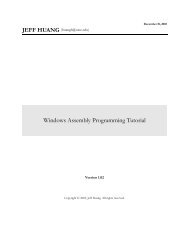Beej's Guide to Network Programming Using Internet Sockets
Beej's Guide to Network Programming Using Internet Sockets
Beej's Guide to Network Programming Using Internet Sockets
- No tags were found...
Create successful ePaper yourself
Turn your PDF publications into a flip-book with our unique Google optimized e-Paper software.
Beej’s <strong>Guide</strong> <strong>to</strong> <strong>Network</strong> <strong>Programming</strong> <strong>Using</strong> <strong>Internet</strong> <strong>Sockets</strong> 29#include #include #include #include #define STDIN 0int main(void){struct timeval tv;fd_set readfds;tv.tv_sec = 2;tv.tv_usec = 500000;FD_ZERO(&readfds);FD_SET(STDIN, &readfds);// file descrip<strong>to</strong>r for standard input// don’t care about writefds and exceptfds:select(STDIN+1, &readfds, NULL, NULL, &tv);if (FD_ISSET(STDIN, &readfds))printf("A key was pressed!\n");elseprintf("Timed out.\n");}return 0;If you’re on a line buffered terminal, the key you hit should be RETURN or it will time outanyway.Now, some of you might think this is a great way <strong>to</strong> wait for data on a datagram socket–andyou are right: it might be. Some Unices can use select in this manner, and some can’t. You shouldsee what your local man page says on the matter if you want <strong>to</strong> attempt it.Some Unices update the time in your struct timeval <strong>to</strong> reflect the amount of time stillremaining before a timeout. But others do not. Don’t rely on that occurring if you want <strong>to</strong> beportable. (Use gettimeofday() if you need <strong>to</strong> track time elapsed. It’s a bummer, I know, butthat’s the way it is.)What happens if a socket in the read set closes the connection? Well, in that case, select()returns with that socket descrip<strong>to</strong>r set as “ready <strong>to</strong> read”. When you actually do recv() from it,recv() will return 0. That’s how you know the client has closed the connection.One more note of interest about select(): if you have a socket that is listen()ing, you cancheck <strong>to</strong> see if there is a new connection by putting that socket’s file descrip<strong>to</strong>r in the readfds set.And that, my friends, is a quick overview of the almighty select() function.But, by popular demand, here is an in-depth example. Unfortunately, the difference betweenthe dirt-simple example, above, and this one here is significant. But have a look, then read thedescription that follows it.This program 17 acts like a simple multi-user chat server. Start it running in one window, thentelnet <strong>to</strong> it (“telnet hostname 9034”) from multiple other windows. When you type something inone telnet session, it should appear in all the others./*** selectserver.c -- a cheezy multiperson chat server*/17 http://beej.us/guide/bgnet/examples/selectserver.c












